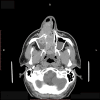Synchronous Sinonasal Inverted Papilloma With Nasolacrimal Squamous Cell Carcinoma: An Uncommon Case Report of Malignant Transformation of Inverted Papilloma
- PMID: 40717871
- PMCID: PMC12296299
- DOI: 10.7759/cureus.88755
Synchronous Sinonasal Inverted Papilloma With Nasolacrimal Squamous Cell Carcinoma: An Uncommon Case Report of Malignant Transformation of Inverted Papilloma
Abstract
Nasolacrimal tumors are exceedingly rare head and neck pathologies. They are locally invasive and have an increased possibility of aggressive malignant transformation. These tumors are clinically presented with a palpable mass, obstruction of nasolacrimal drainage, epiphora, and nasal congestion. Nasolacrimal carcinomas are rare malignancies that often take a long time before the correct diagnosis is made. The combination of endoscopic and open en-bloc resection can provide complete removal of locally advanced nasolacrimal tumors. A multidisciplinary team, chemo-radiotherapy, and follow-up monitoring are essential for the effective management of such tumors. We report a case of a 41-year-old male patient with presentation of epiphora and a paranasal lump. Imaging showed an advanced nasolacrimal tumor with infiltration of surrounding structures. Pathologic examination demonstrated nasolacrimal keratinizing squamous cell carcinoma (SCC) associated with sinonasal inverted papilloma. A multidisciplinary approach, including radical surgery and chemo-radiotherapy, rendered success in achieving remission with a four-year disease-free follow-up.
Keywords: inverted papilloma; lacrimal sac; malignancy; nasolacrimal duct system; sinonasal; squamous cell carcinoma.
Copyright © 2025, Kasaboglu et al.
Conflict of interest statement
Human subjects: Informed consent for treatment and open access publication was obtained or waived by all participants in this study. Conflicts of interest: In compliance with the ICMJE uniform disclosure form, all authors declare the following: Payment/services info: This research is supported by the Bulgarian Ministry of Education and Science under the National Programme "Young Scientists and Postdoctoral Students-2". Financial relationships: All authors have declared that they have no financial relationships at present or within the previous three years with any organizations that might have an interest in the submitted work. Other relationships: All authors have declared that there are no other relationships or activities that could appear to have influenced the submitted work.
Figures



Similar articles
-
Case Report: "DEK::AFF2 fusion associated sinonasal carcinomas: a novel oncogenic driver and emerging therapeutic strategies".Front Immunol. 2025 Jul 4;16:1611790. doi: 10.3389/fimmu.2025.1611790. eCollection 2025. Front Immunol. 2025. PMID: 40688086 Free PMC article.
-
Probing for congenital nasolacrimal duct obstruction.Cochrane Database Syst Rev. 2017 Jul 12;7(7):CD011109. doi: 10.1002/14651858.CD011109.pub2. Cochrane Database Syst Rev. 2017. PMID: 28700811 Free PMC article.
-
Deep learning using nasal endoscopy and T2-weighted MRI for prediction of sinonasal inverted papilloma-associated squamous cell carcinoma: an exploratory study.Eur Radiol Exp. 2025 Jul 21;9(1):68. doi: 10.1186/s41747-025-00610-0. Eur Radiol Exp. 2025. PMID: 40691342 Free PMC article.
-
Malignant transformation of sinonasal inverted papilloma and related genetic alterations: a systematic review.Eur Arch Otorhinolaryngol. 2017 Aug;274(8):2991-3000. doi: 10.1007/s00405-017-4571-2. Epub 2017 Apr 21. Eur Arch Otorhinolaryngol. 2017. PMID: 28432463
-
Differences in Imaging and Histology Between Sinonasal Inverted Papilloma with and Without Squamous Cell Carcinoma.Diagnostics (Basel). 2025 Jun 27;15(13):1645. doi: 10.3390/diagnostics15131645. Diagnostics (Basel). 2025. PMID: 40647644 Free PMC article.
References
Publication types
LinkOut - more resources
Full Text Sources
Research Materials
